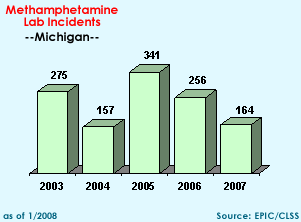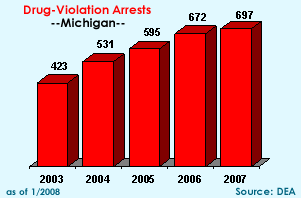|
DEA
Offices & Telephone Nos.
Detroit—313-234-4000
East Lansing—517-337-6604
Grand Rapids—616-458-0616
Saginaw—517-754-2330 |
State Facts
Population: 10,120,860
State Prison Population: 48,883
Probation Population: 176,083
Violent Crime Rate
National Ranking: 17 |
2007
Federal Drug Seizures
Cocaine: 295.9 kgs./2 du
Heroin: 9.1 kgs.
Methamphetamine: 0.4 kgs./789
du
Marijuana: 2,649.8 kgs.
Hashish: 0.1 kgs.
MDMA: 53.3 kgs./719,139 du
Meth
Lab Incidents: 164
(DEA, state, and local) |
Drug
Situation: Cocaine, heroin, marijuana, and MDMA are the primary drug threats in the state of Michigan. Mexican DTOs, with direct ties to the Southwest Border and links to major Colombian cocaine cartels, are responsible for the lion share of the cocaine distributed in Michigan. Cocaine is either resold to local distributors or converted into crack cocaine for street distribution. The availability of South American heroin remains constant throughout Michigan, although Mexican Brown heroin and Mexican black tar heroin is available. Southwest Asian heroin is readily available in the Detroit metropolitan area with New York as the primary point of origin for the influx of Southwest Asian heroin. Importation of Canadian marijuana, often referred to as “B.C. Bud”, along with MDMA, by Asian organized crime groups at Michigan’s Northern Border ports of entry is encountered with increased frequency. Detroit, Port Huron, and Sault Ste. Marie are quickly becoming transshipment areas to the rest of the United States. Cocaine from the Southwest Border is smuggled north into Canada at these same ports of entry
 Cocaine: Cocaine and crack cocaine trafficking and abuse remain at high levels within the state of Michigan. Wholesale distribution cells operating in the major cities of Michigan are directed by Mexican drug trafficking organizations that have direct links to Colombian cartels. Local crack distribution cells dominate inner city trafficking activities. These organizations are frequently involved in violence in conjunction with their illicit activities. Cocaine purity levels range between 40% to 90% and quantities can be purchased in amounts ranging from grams to several kilograms. Cocaine: Cocaine and crack cocaine trafficking and abuse remain at high levels within the state of Michigan. Wholesale distribution cells operating in the major cities of Michigan are directed by Mexican drug trafficking organizations that have direct links to Colombian cartels. Local crack distribution cells dominate inner city trafficking activities. These organizations are frequently involved in violence in conjunction with their illicit activities. Cocaine purity levels range between 40% to 90% and quantities can be purchased in amounts ranging from grams to several kilograms.
 Heroin:
Heroin is widely available throughout the Detroit metropolitan area and the more densely populated areas of Michigan. Large quantities of heroin are imported from South America, Mexico and Africa. Southeast and southwest Asian heroin is available in the metropolitan Detroit area; however, South American heroin is the most abundant. Major heroin trafficking organizations in Michigan are inner-city and Hispanic. The city of Detroit is a transshipment area to other communities in Michigan and Ohio, as well as a consumption city. Heroin:
Heroin is widely available throughout the Detroit metropolitan area and the more densely populated areas of Michigan. Large quantities of heroin are imported from South America, Mexico and Africa. Southeast and southwest Asian heroin is available in the metropolitan Detroit area; however, South American heroin is the most abundant. Major heroin trafficking organizations in Michigan are inner-city and Hispanic. The city of Detroit is a transshipment area to other communities in Michigan and Ohio, as well as a consumption city.
  Methamphetamine: Small “Mom and Pop” and “Tweaker” operators continue to manufacture methamphetamine in small one to two ounce quantities for personal use and for distribution at the local level. The primary producers of methamphetamine are Caucasian and Hispanic males. Methamphetamine: Small “Mom and Pop” and “Tweaker” operators continue to manufacture methamphetamine in small one to two ounce quantities for personal use and for distribution at the local level. The primary producers of methamphetamine are Caucasian and Hispanic males.
 MDMA
and Other Club Drugs: The Northern Border in Detroit serves as a transshipment point for multi-thousand dosage unit quantities of predatory and club drugs, such as MDMA and GHB. Middle Eastern and Caucasian criminal groups, Asian groups, independent inner-city groups, and area college students transport MDMA primarily from the Toronto area of Canada into the United States. MDMA and other club drugs are then transported to other areas of the country. Cocaine and drug proceeds in bulk currency are transported into Canada at the Northern Border in Detroit. MDMA
and Other Club Drugs: The Northern Border in Detroit serves as a transshipment point for multi-thousand dosage unit quantities of predatory and club drugs, such as MDMA and GHB. Middle Eastern and Caucasian criminal groups, Asian groups, independent inner-city groups, and area college students transport MDMA primarily from the Toronto area of Canada into the United States. MDMA and other club drugs are then transported to other areas of the country. Cocaine and drug proceeds in bulk currency are transported into Canada at the Northern Border in Detroit.
  Marijuana: The Northern Border is increasingly utilized to transport Canadian indoor-grown marijuana, referred to as B.C. Bud, into the United States at Michigan ports of entry. B.C. Bud has a higher tetrahydrcannabinol (THC) content than domestically grown or Mexican produced marijuana. As a result, the demand for B.C. Bud is significantly increasing. Significant marijuana seizures at the Northern Border ports of entry in Michigan have increased. Multi-hundred pound seizures of B.C. Bud are regularly transported across the Northern Border. The Northern Border Ambassador Bridge located at the Detroit, Michigan/Windsor, Ontario port of entry is the busiest commercial land border entry port in the world, making the detection of marijuana commingled with legitimate goods a daunting task. Marijuana transported into Michigan from the Southwest Border is primarily distributed by Mexican and inner-city trafficking organizations. Marijuana: The Northern Border is increasingly utilized to transport Canadian indoor-grown marijuana, referred to as B.C. Bud, into the United States at Michigan ports of entry. B.C. Bud has a higher tetrahydrcannabinol (THC) content than domestically grown or Mexican produced marijuana. As a result, the demand for B.C. Bud is significantly increasing. Significant marijuana seizures at the Northern Border ports of entry in Michigan have increased. Multi-hundred pound seizures of B.C. Bud are regularly transported across the Northern Border. The Northern Border Ambassador Bridge located at the Detroit, Michigan/Windsor, Ontario port of entry is the busiest commercial land border entry port in the world, making the detection of marijuana commingled with legitimate goods a daunting task. Marijuana transported into Michigan from the Southwest Border is primarily distributed by Mexican and inner-city trafficking organizations.
 OxyContin®: OxyContin® demand
is increasing throughout the state. The Michigan Automated Prescription
System (MAPS) program indicates that the state’s OxyContin® prescriptions
have increased by 31 percent. Michigan is ranked number 30 for its OxyContin® comsumption
per capita. Straits Area Narcotic Enforcement (SANE) Task Force, located
in Cheboygan County, Michigan reported that 90 percent of the problems
encountered are related to OxyContin®. The number of charges for OxyContin® abuse
has also increased. In 2002, there were 37 charges made as compared to
60 in 2003. OxyContin® abusers are obtaining
this drug through break-ins and robberies, doctor shopping, stealing from
legitimate
patients,
selling
parts of legitimate
prescriptions, home break-ins and forged prescriptions. OxyContin®: OxyContin® demand
is increasing throughout the state. The Michigan Automated Prescription
System (MAPS) program indicates that the state’s OxyContin® prescriptions
have increased by 31 percent. Michigan is ranked number 30 for its OxyContin® comsumption
per capita. Straits Area Narcotic Enforcement (SANE) Task Force, located
in Cheboygan County, Michigan reported that 90 percent of the problems
encountered are related to OxyContin®. The number of charges for OxyContin® abuse
has also increased. In 2002, there were 37 charges made as compared to
60 in 2003. OxyContin® abusers are obtaining
this drug through break-ins and robberies, doctor shopping, stealing from
legitimate
patients,
selling
parts of legitimate
prescriptions, home break-ins and forged prescriptions.
Pharmaceutical Diversion: The abuse and diversion of prescription drugs, particularly hydrocodone, oxycodone (Lortab, Lorcet, Vicodin, and Oxycontin), and methadone, is increasing throughout the state. Detroit is a source city for OxyContin that is transported and distributed to users in Kentucky and West Virginia for a high profit margin. Primary methods of diversion are illegal sales, “doctor shopping”, pharmacy break-ins and robberies, stealing from legitimate patients, selling legitimate prescriptions, illegally obtaining them from the streets, illegitimate prescriptions, home break-ins, forged prescriptions, and Internet pharmacies.
 DEA Mobile Enforcement Teams: This cooperative program with state and local law enforcement counterparts was conceived in 1995 in response to the overwhelming problem of drug-related violent crime in towns and cities across the nation. Since the inception of the MET Program, 473 deployments have been completed nationwide, resulting in 19,643 arrests. There have been 13 MET deployments in the State of Michigan since the inception of the program: Pontiac, Ypsilanti, Lincoln Park/Melvindale, Inkster, Muskegon, Benton Harbor (2), Mt. Clemens, Flint (2), Lansing, Detroit, and Mt. Pleasant. DEA Mobile Enforcement Teams: This cooperative program with state and local law enforcement counterparts was conceived in 1995 in response to the overwhelming problem of drug-related violent crime in towns and cities across the nation. Since the inception of the MET Program, 473 deployments have been completed nationwide, resulting in 19,643 arrests. There have been 13 MET deployments in the State of Michigan since the inception of the program: Pontiac, Ypsilanti, Lincoln Park/Melvindale, Inkster, Muskegon, Benton Harbor (2), Mt. Clemens, Flint (2), Lansing, Detroit, and Mt. Pleasant.
DEA
Regional Enforcement Teams:
This program was designed to augment existing DEA division resources
by targeting drug organizations operating in the United States where
there is a lack of sufficient local drug law enforcement. This program
was conceived in 1999 in response to the threat posed by drug trafficking
organizations that have established networks of cells to conduct drug
trafficking operations in smaller, non-traditional trafficking locations
in the United States. As of January 31, 2005, there have been 27 deployments
nationwide, and one deployment in the U.S. Virgin Islands, resulting
in 671 arrests. There have been no RET deployments in the state of Michigan.
Special
Topics: High Intensity Drug Trafficking Areas. Based
on drug trafficking trends, in 2002, specifically the increased
production of methamphetamine
in the
western portion of
Michigan, additional funding was secured from ONDCP to expand HIDTA.
This expansion was comprised of the addition of the five counties of
Allegan, Genesee, Kalamazoo, Kent, and Van Buren. The HIDTA is now known
as the Michigan HIDTA and its area of responsibility includes the cities
of Grand Rapids, Flint, Kalamazoo, and Detroit and accounts for approximately
60 percent of the population of Michigan.
The Michigan HIDTA
is responsible for supplying funding and assistance to 22 initiatives,
of which 17 are federal, state and
local drug task forces. These initiatives have been designed to address
specific drug related threats in their areas of responsibility. The Michigan
HIDTA also funds an Intelligence Support and Deconfliction Center (ISDC)
located in Detroit. The mission of the ISDC is to provide law enforcement
agencies with timely deconfliction and intelligence support through the
sharing of multi-agency information related to international and domestic
narcotics trafficking, violent crimes, and terrorists activities.
Currently, the following
agencies participate in the Michigan HIDTA: Drug Enforcement Administration,
Federal Bureau of Investigation, Internal
Revenue Service, Bureau of Immigration & Customs Enforcement, Bureau
of Alcohol, Tobacco & Firearms, U.S. Coast Guard, U.S. Customs and
Border Protection, U.S. Marshall Service, Michigan State Police, Detroit
Police Department, Grand Rapids Police Department, Kalamazoo Police Department,
Flint Police Department, Sheriff’s
Departments from the nine HIDTA counties, Michigan National Guard, Michigan
Office of Drug Control Policy and many other local law enforcement agencies.
More information
about the Detroit Division Office.
Sources
Factsheet
last updated:
3/2008
Click
here for last year's factsheet >>
|

